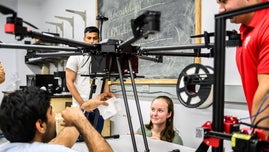WPI researcher awarded $564K to advance research on cell antennae
 Photo | Courtesy of Worcester Polytechnic Institute
Worcester Polytechnic Institute researcher and assistant professor in the Department of Biology and Biotechnology, Inna Nechipurenko
Photo | Courtesy of Worcester Polytechnic Institute
Worcester Polytechnic Institute researcher and assistant professor in the Department of Biology and Biotechnology, Inna Nechipurenko
A Worcester Polytechnic Institute researcher and assistant professor in the Department of Biology and Biotechnology, Inna Nechipurenko has received two grants totaling $564,000 to advance her study into how cellular structures called cilia affect the development of neurodevelopmental disorders.
“You can think of primary cilia as tiny antennae that project from the surface of nearly all cells in our bodies, and these antennae are absolutely essential for our cells to be able to communicate with each other and to collect information about their environment,” Nechipurenko said in a Wednesday report from WPI. “Their critical importance for human health is particularly highlighted by the fact that people who have any defects in the function of these structures suffer from devastating genetic disorders, for which there is no cure.”
Malfunctions in the structures have been linked to 30 disorders ranging from polycystic kidney disease to autism spectrum disorder.
“Although much progress has been made in the past 20 years to better understand all cellular roles that primary cilia play and why or how their dysfunction may lead to diseases, many questions remain,” Nechipurenko said. “We are particularly excited to begin asking how cilia functions intersect with other aspects of neuronal physiology, and why it is so detrimental to neurons if cilia do not function just right.”
The National Institutes of Health granted $363,984 over three years to study how a specific gene affects cilia structure and function in neurons.
The Charles H. Hood Foundation in Boston granted $200,000 over two years to study the effect a mutations in a different gene, known to be a risk marker for neurodevelopmental disorders, has on cilia structure.













0 Comments